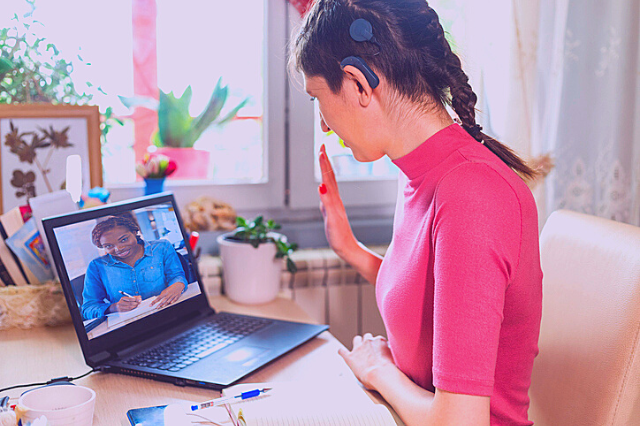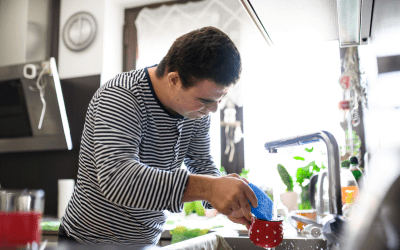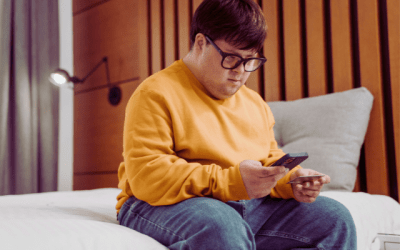Using Remote Supports
Picking the right help for someone with Intellectual and Developmental disabilities (I/DD) can be a challenge. If you don’t pick the right fit, they may be unhappy with the services, or it could even limit what they can do in their day-to-day life..
This is why it’s important to know what Remote Supports can look like in the life of a person with a disability. It will go a long way to the making of an informed choice when selecting support services.
This article will share what a day in the life of a person with I/DD using Remote Supports services looks like and how it can benefit those with disabilities and their caregivers.
A day in the life of a person with disabilities using Remote Supports.

Introducing Bethany, a 33-year-old individual who has Autism. Let’s take a closer look at what a typical day with Remote Supports might be like for her.
Morning Routine
8:30 AM
It’s breakfast time. Bethany, decides to make eggs and toast.
9:15 AM
Remote Supports use a specially configured tablet to call Bethany. This allows them to connect with each other quickly and easily. This tablet is an assistive device.
Bethany: Hello.
Remote Supports: Hi Bethany, how are you doing this morning?
Bethany: I’m doing alright, how about you?
Remote Supports:I’m doing great. Bethany, what did you have for breakfast this morning?
Bethany: I had some scrambled eggs and toast.
Remote Supports: That sounds delicious! By the way, did you get a chance to take your medication yet?
Bethany: Oh, not yet. Let me go get it.
Bethany gets her medication and takes it in front of the Remote Supports staff while on call.
Remote Supports: That’s great, Bethany. What are you working on at work today?
Bethany: Today, I think we’re making blankets.
Remote Supports: That’s awesome, Bethany! Are you looking forward to making a blanket today? Will you be making one for yourself?
Bethany: Yes, I can’t wait to get started! And I’m making one in my favorite colors, purple and pink.
Remote Supports: That sounds like a fantastic choice! Let me know how it turns out next time we speak. One more thing, just remember to take your keys with you when you go out.
Remote Supports staff writes a note about the conversation in the SafeinHome support notes.
10:00 AM
It’s time for work. Bethany takes a bus to work. Bethany takes her keys and a Geocomm, a two-way communication assistive device that Bethany can use to connect with Remote Supports.
Bethany can use the Geocomm to talk to her Remote Supports Staff and have them locate her, should she get lost or turned around. She can also talk to six other people that’s part of her support circle.
Evening Routine
4:00 PM
It’s time to go home. Bethany takes the bus and arrives home safely. Sometimes, she likes to stop for ice cream, and other times, she visits her local grocery store. She picks up snacks or cooking supplies. When she gets home, she begins preparing dinner.
4:30 PM
Bethany begins her cooking, Bethany but gets distracted by the TV in the living room, where “Charlie’s Angels” is playing. She enjoys this show and had shared with SafeinHome that she likes to prepare meals, but can get distracted.
Bethany gets so engrossed in the show that she completely forgets about the simmering pot on the stove. Fortunately, her kitchen is equipped with an automatic stove shut-off, which has a motion sensor. It senses no movement in front of the stove for more than five minutes and automatically turns off the stove. It also sends an alert to the Remote Supports Staff to ensure Bethany’s safety.
Following the automatic shut-off, Remote Supports Staff immediately calls Bethany to check in on her and make sure she’s okay.
Remote Supports: (calling Bethany) “Hi Bethany, we noticed the stove was turned off because it was unattended. Are you okay?”
Bethany: “Oh, I’m fine. I got distracted watching ‘Charlie’s Angels.’ I’m sorry.”
Remote Supports: “We’re just glad you’re okay, Bethany. What are you cooking today?”
Bethany: “I’m making spaghetti.”
Remote Supports: “That sounds delicious! How about you pause your TV for a moment, finish up your cooking, and then enjoy your meal while watching ‘Charlie’s Angels’? It’s a great way to have a relaxing dinner.”
Bethany: “That’s a good idea. I’ll do that. Thanks for looking out for me!”
6:00 PM
Remote Supports calls Bethany on the tablet, for their daily evening check-in call.
Remote Supports: (calling Bethany) “Hi Bethany, how was dinner?
Bethany: “It was good. I finished the Spaghetti and made a red sauce to go with it.
Remote Supports: “That’s wonderful to hear, Bethany. That sounds yummy. Did you remember to take your medication today?”
Bethany: “Yes, I took it as soon as I got home.”
Remote Supports: “Great job! Now, how was blanket-making today?”
Bethany: “It was great! I got to pick my colors and designed a pattern”
Remote Supports: “Oh wow! That sounds really exciting. I can’t wait to see it. Are you all set for the night?
Bethany: Yes!
Remote Supports: Have a relaxing evening, Bethany, and let us know if you need anything. We hope you have a restful night.
Support On-Demand
8:30 PM
Bethany hears a dog barking outside and gets scared. She touches the button on her tablet to connect to Remote Supports.
Remote Supports: Hi Bethany, is everything alright?
Bethany: No, I heard a dog barking.
Remote Supports: I’m sorry to hear that, where is the dog right now?
Bethany: I can see it outside the window.
Remote Supports: And all the doors are shut and locked?
Bethany: Yes.
Remote Supports: That’s very good. That means that dog cannot get in. You know, Brittany, sometimes dogs bark when they see people walk by – do you see people outside nearby?
Bethany: Let me go look, hold on. Bethany looks and returns. Oh, there are a bunch of kids walking on the other side of the street.
Remote Supports: That’s probably why the dog is barking. He will calm down once they are gone.
Bethany: Oh yes, he is not barking anymore.
Remote Supports: Great! Are you feeling better?
Bethany: Yes. Thank you!
Remote Supports: Glad to help. Have a good night,
10:00 PM
Bethany calls in to Remote Supports for someone to talk with before she goes to bed.
Remote Supports: Hi Bethany, how are you?
Bethany: I’m doing good, much better now.
Remote Supports: Are you about to go to bed?
Bethany: Yes, much better, thank you.
Bethany hangs up with Remote Supports and goes to bed. Ready to start a brand new day.
What are the benefits of Remote Supports for People with I/DD and Caregivers?
More Freedom and Safety: First off, Remote Supports help people with I/DD be more independent. They can get a hand when they need it, but still do things on their own. Plus, they increase people’s capacity in their daily lives with devices like automatic stove shut-offs and GPS locators. Effectively increasing autonomy while receiving the needed support.
Feeling Good About Themselves: Remote Supports make people feel better about themselves because they can do more things. That’s like a confidence boost! They learn to speak up and say what they want, making sure their unique needs are met.
Reduced Feelings Isolation: Remote Supports help to reduce feelings of isolation and loneliness. Remote Support staff encourage connections with trusted friends and family. And they are always available when a person with a disability needs support.
Reduced Caregiver Stress: Remote Supports help reduce the stress and let caregivers take a breather. They can get assistance when they need it, giving them more time for other things they love.




